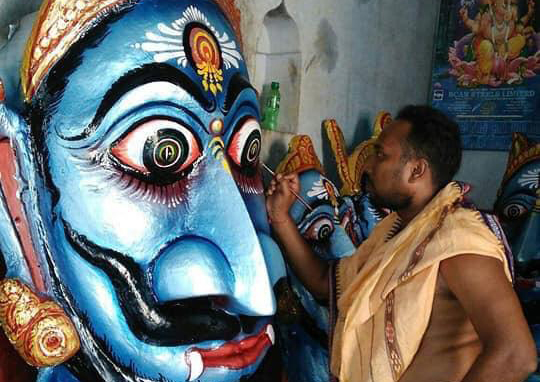Come Dussehra and once again the victory of good over evil will be celebrated amid much fanfare across the country. On home turf, the scene isn’t any different. With just a few days to go for Dussehra, preparations for Ravana Podi are in full swing. Every year, the Twin City hosts quite a few big Ravana Podi events that are attended by lakhs of people. That said, preparing the giant effigies of Ravana is quite a difficult and intricate process. Most of these effigies that go up in smoke every Dussehra are made by artisans from different parts of the state. However, much like idol making, effigy making too is a specialised area. And Sanjit Mohapatra definitely is a name to reckon with in this regard. Sanjit is one of the most sought-after names when it comes to making giant effigies of the 10-headed demon king.
Sanjit, who has been in the profession of making effigies of Ravana for the last two decades, gets busy days ahead of Dussehra every year, with orders pouring in from different parts of the state. Besides heading a team of 20 craftsmen, Sanjit is also assisted by his family members in making these 40 to 45 feet tall effigies. Each effigy costs around Rs 50,000 and is prepared with utmost care and is handed over to the puja committees a few days ahead of Vijaya Dashami.
However, Sanjit and his family do not prepare these effigies only for the sake of making some money. In a candid conversation with Sunday POST, Sanjit shares his story behind choosing this profession and the art of effigy making.
Sanjit, who hails from Dasapalla, famous for holding a 12-day-long Ravana Podi festival, says, “We earn our livelihood primarily by making Pattachitra and other handicrafts throughout the year. But making Ravana effigies is a family tradition. We could have done something else to make more money but this is something we take pride in doing. Our forefathers started it and we are carrying forward the legacy. Since we are artisans, making effigies isn’t very difficult for us. However, not all artisans make effigies. We take pride in making these effigies.”
Sanjit has a fixed clientele comprising Durga Puja committees from Bhawanipatna, Bhubaneswar and Sonepur. Every year, Sanjit and his team get busy a month ahead of Durga Puja. Much like in Durga Puja, where idols come in a set, Ravana’s effigy too comes in a set. The main effigy is of the demon king, while there are smaller effigies of his siblings which go up in flames on the last day of Dussehra.
“Effigy making is not everyone’s cup of tea. It is an intricate process. First, bamboo is torn into thin strips and bent to prepare the frame on which the effigy will be hung. The frame is then covered with old sarees and subsequently pasted with brown paper. The veneer is mostly painted in black but we change it if the client demands a different backdrop,” he says.
The toughest part is creating the head. Making the eyes and the mouth requires finesse and high level of skill. Everything in an effigy is painstakingly made by hand.
“Once the raw material is taken care of, craftsmen get on their toes. After assembling the poles, mounting the cloth and painting the figures, the effigy is finally ready. It sounds easy but it takes 30 to 35 days to make each effigy,” says Sanjit, who accepts seven orders every year and charges approximately Rs 50,000 per effigy.
However, the price varies depending on the size. Most puja committees go for 35-feet-high Ravana effigies, while some demand even 45 to 50-feet-tall effigies.
“Although we all are from Dasapalla, we go to different places to make these effigies instead of making them in our workshop and then transporting them. We prefer this arrangement to avoid damage to the effigies while in transit. I oversee my team members and assist them,” he says.
That said, Sanjit says it is always tough for a craftsman to see his labour of 20 to 25 days burning to ashes in a few hours. “I learnt the art watching my father. He was a perfectionist. I was more into making idols and Patachittra but after watching my father I developed an interest in making effigies of Ravana. I picked up the art of making effigies in no time and my father was proud of me,” he says.
Later, Sanjit passed on the tricks of the trade to his wife and brother. “Effigy making is not a lucrative business, but we do it because we want to carry forward the legacy of our forefather. Moreover, we love doing this. Every family member chips in to make the effigy that we make for the Dasapalla Ravana Podi,” he says.
RASHMI REKHA DAS, OP

